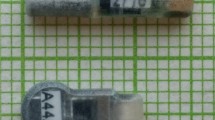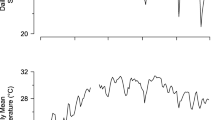Abstract
Telemetry has proven an effective means for studying the movement of fishes, however, biases associated with tagged animals requires careful scrutiny if accurate conclusions are to be made from field studies. The objective of this study was to evaluate growth, survival, and tag retention in hatchery yearling Chinook salmon (Oncorhynchus tshawytscha) juveniles with intracoelomic surgically implanted acoustic transmitters representing 2.6 to 5.6% of body weight. The first trial consisted of three treatments; passive integrated transponder (PIT) tag-only (25 fish), acoustic-tag+PIT-tag (25 fish), and sham-surgery+PIT-tag (25 fish). There were no significant differences in relative growth rate (% change in weight day−1) among treatments over the 221 day trial. Survival in the acoustic-tag treatment (80%) was not significantly different from the PIT-tag-only and sham treatments (92 and 88% respectively). The second trial consisted of three treatments; PIT-tag-only (22 fish), acoustic-tag+PIT-tag with absorbable sutures (12 fish) and acoustic-tag+PIT-tag with non-absorbable sutures (12 fish). There were no significant differences in relative growth rate among treatments over the 160 day trial. Survival in the second trial was 100%. Fish with absorbable sutures healed sooner and with less inflammation compared to fish with non-absorbable sutures. Tag retention was 100% in both trials. The results of this study suggest that acoustic transmitters of less than 5.6% body weight can be effectively used in 1-year old Chinook salmon.




Similar content being viewed by others
References
Adams NS, Rondorf DW, Evans SD, Kelly JE (1998a) Effects of surgically and gastrically implanted radio transmitters on growth and feeding behavior of juvenile Chinook salmon. Trans Am Fish Soc 127:128–136
Adams NS, Rondorf DW, Evans SD, Kelly JE, Perry RW (1998b) Effects of surgically and gastrically implanted radio transmitters on swimming performance and predator avoidance of juvenile Chinook salmon (Oncorhynchus tshawytscha). Can J Fish Aquat Sci 55:781–787
Anglea SM, Geist DR, Brown RS, Deters KA, McDonald RD (2004) Effects of acoustic transmitters on swimming performance and predator avoidance of juvenile Chinook salmon. North Am J Fish Manag 24:162–170
Beckman BR, Larsen DA, Sharpe C, Lee-Pawlak B, Schreck CB, Dickhoff WW (2000) Physiological status of naturally reared juvenile spring Chinook salmon in the Yakima River: Seasonal dynamics and changes associated with smolting. Trans Am Fish Soc 129:727–753
Brown RS, Cooke SJ, Anderson WG, McKinely RS (1999) Evidence to challenge the “2% rule” for biotelemetry. North Am J Fish Manag 19:867–871
Brown RS, Geist DR, Deters KA, Grassell A (2006) Effects of surgically implanted acoustic transmitters > 2% of body mass on the swimming performance, survival and growth of juvenile sockeye and Chinook salmon. Journal of Fish Biology 69:1626–1638
Brown RS, Carlson TJ, Welch AE, Stephenson JR, Abernethy CS, Ebberts BD, Langeslay MJ, Ahmann ML, Feil DH, Skalski JR, Townsend RL (2009) Assessment of barotrauma from rapid decompression of depth-acclimated juvenile Chinook salmon bearing radiotelemetry transmitters. Trans Am Fish Soc 138:1285–1301
Brown RS, Harnish RA, Carter KM, Boyd JW, Deters KA, Eppard MB (2010) An evaluation of the maximum tag burden for implantation of acoustic transmitters in juvenile Chinook salmon. North Am J Fish Manag 30:499–505
Chapman ED, Hearn AR, Michel CJ, Sandstrom PT, Ammann AJ, Thomas MJ, Singer GP, Peterson ML, Lindley SL, MacFarlane RB (2012) Diel movements of outmigrating Chinook salmon (Oncorhynchus tshawytscha) and steelhead (O. mykiss) smolts in the Sacramento/San Joaquin watershed. Environmental Biology of Fishes, (this issue)
Chittenden CM, Butterworth KG, Cubitt KF, Jacobs MC, Ladouceur A, Welch DW, McKinley RS (2009) Maximum tag to body size ratios for an endangered coho salmon (O. kisutch) stock based on physiology and performance. Environ Biol Fish 84:129–140
Connors KB, Scruton D, Brown JA, McKinley RS (2002) The effects of surgically-implanted dummy radio transmitters on the behaviour of wild Atlantic salmon smolts. Hydrobiologia 483:231–237
Cooke SJ, Woodley CM, Eppard MB, Brown RS, Nielsen JL (2011) Advancing the surgical implantation of electronic tags in fish: A gap analysis and research agenda based on a review of trends in intracoelomic tagging effects studies. Rev Fish Biol Fisher 21:127–151
Deters KA, Brown RS, Carter KM, Boyd JW, Eppard MB, Seaburg AG (2010) Performance assessment of suture type, water temperature, and surgeon skill in juvenile Chinook salmon surgically implanted with acoustic transmitters. Trans Am Fish Soc 139:888–899
Frost DA, McComas RL, Sandford BP (2010) The effects of a surgically implanted microacoustic tag on growth and survival in subyearling fall Chinook salmon. Trans Am Fish Soc 139:1192–1197
Hall JE, Chamberlin J, Kagley AN, Greene C, Fresh KL (2009) Effects of gastric and surgical insertions of dummy ultrasonic transmitters on juvenile Chinook salmon in seawater. Trans Am Fish Soc 138:52–57
Jepsen N, Davis LE, Schreck CB, Siddens B (2001) The physiological response of Chinook salmon smolts to two methods of radio-tagging. Trans Am Fish Soc 130:495–500
Jepsen N, Koed A, Thorstad EB, Baras E (2002) Surgical implantation of telemetry transmitters in fish: how much have we learned? Hydrobiologia 483:239–248
Jepsen N, Schreck C, Clements S, Thorstad EB (2003) A brief discussion on the 2% tag/body mass rule of thumb. In: Spedicato MT, Lembo G, Marmulla G (eds.) Aquatic telemetry: advances and applications. Proceedings of the Fifth Conference on Fish Telemetry held in Europe, FAO/COISPA, Ustica, Italy, pp. 255–259
Jepsen N, Christoffersen M, Munksgaard T (2008) The level of predation used as an indicator of tagging/handling effects. Fish Manag Ecol 15:365–368
Knights BC, Lasee BA (1996) Effects of implanted transmitters on adult bluegills at two temperatures. Trans Am Fish Soc 125(3):440–449
Lacroix GL, Knox D, McCurdy P (2004) Effects of implanted dummy acoustic transmitters on juvenile Atlantic salmon. Trans Am Fish Soc 133:211–220
Lindley ST, Moser ML, Erickson DL, Belchik M, Welch DW, Rechisky EL, Kelly JT, Heublein J, Klimley AP (2008) Marine migration of North American green sturgeon. Trans Am Fish Soc 137:182–194
Martinelli TL, Hansel HC, Shively RS (1998) Growth and physiological responses to surgical and gastric radio transmitter implantation techniques in subyearling Chinook salmon (Oncorhynchus tshawytscha). Hydrobiologia 372:79–87
Melnychuk MC, Welch DW, Walters CJ (2010) Spatio-temporal migration patterns of pacific salmon smolts in rivers and coastal marine waters. PLoS One 5(9):e12916. doi:10.1371/journal.pone.0012916
Michel CJ, Ammann AJ, Chapman ED, Sandstrom PT, Fish HE, Thomas MJ, Singer GP, Lindley ST, Klimley AP, Macfarlane RB (2012) The effects of environmental factors on the migratory movement patterns of Sacramento River yearling late-fall run Chinook salmon (Oncorhynchus tshawytscha). Environmental Biology of Fish. (this issue)
Perry RW, Adams NS, Rondorf DW (2001) Buoyancy compensation of juvenile Chinook salmon implanted with two different size dummy transmitters. Trans Am Fish Soc 130:46–52
Perry RW, Skalski JR, Brandes PL, Sandstrom PT, Klimley AP, Ammann A, MacFarlane B (2010) Estimating survival and migration route probabilities of juvenile Chinook salmon in the Sacramento-San Joaquin River Delta. North Am J Fish Manag 30:142–156
Pierce AL, Shearer KD, Baker DM, Dickhoff WW (2001) An autumn profile of growth regulatory hormones in Chinook salmon (Oncorhynchus tshawytscha). Fish Physiol Biochem 25:81–86
Walsh MG, Bjorgo KA, Isely JJ (2000) Effects of implantation method and temperature on mortality and loss of simulated transmitters in hybrid striped bass. Trans Am Fish Soc 129:539–544
Weatherley AH, Gill HS (1995) Growth. In: Groot C, Margolis L, Clarke WC (eds) Physiological ecology of Pacific salmon. University of British Columbia Press, Vancouver, pp 101–158
Welch DW, Batten SD, Ward BR (2007) Growth, survival, and tag retention of steelhead trout (O. mykiss) surgically implanted with dummy acoustic tags. Hydrobiologia 582:289–299
Welch DW, Melnychuk MC, Rechisky ER, Porter AD, Jacobs MC, Ladouceur A, McKinley RS, Jackson GD (2009) Freshwater and marine migration and survival of endangered Cultus Lake sockeye salmon (Oncorhynchus nerka) smolts using post, a large-scale acoustic telemetry array. Can J Fish Aquat Sci 66:736–750
Winter JD (1983) Underwater biotelemetry. American Fisheries Society, Bethesda, pp 371–395
Acknowledgements
This manuscript was greatly improved by the comments of two anonymous reviews, to which we are sincerely grateful. Statistical advice provided by E.J. Dick, A. Pike, and K. Mull. We thank the US Fish and Wildlife Service’s Coleman National Fish Hatchery, especially K. Brown and S. Hamelburg for providing the fish and facilities used in this study. We thank A.P. Klimley of UC Davis for housing fish during a portion of the first trial. We thank H. Fish and E. Sturm for laboratory assistance and support. We thank P. Brandes for providing the active transmitters use in the second trial. Reference to trade names does not imply endorsement by the U.S. Government.
Author information
Authors and Affiliations
Corresponding author
Rights and permissions
About this article
Cite this article
Ammann, A.J., Michel, C.J. & MacFarlane, R.B. The effects of surgically implanted acoustic transmitters on laboratory growth, survival and tag retention in hatchery yearling Chinook salmon. Environ Biol Fish 96, 135–143 (2013). https://doi.org/10.1007/s10641-011-9941-9
Received:
Accepted:
Published:
Issue Date:
DOI: https://doi.org/10.1007/s10641-011-9941-9




